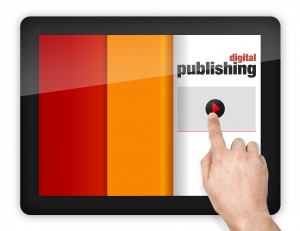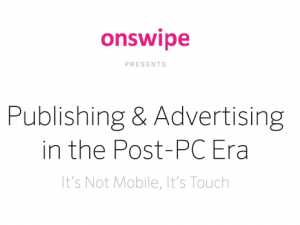Brands
The Contested Future of Content Publishing is Being Created Today
Jason L. Baptiste is running one of Time magazine’s 10 Best Startups of 2011, he’s helping to craft new touchscreen tech for the mobile environment, and he still can’t get over what is happening to the way we work with information.
 “What’s fascinating is that this market barely existed five years ago,” he said Thursday, opening his company Onswipe‘s forum “The State of Publishing and Advertising in the Post PC World” at New Museum in Manhattan.
“What’s fascinating is that this market barely existed five years ago,” he said Thursday, opening his company Onswipe‘s forum “The State of Publishing and Advertising in the Post PC World” at New Museum in Manhattan.
Baptiste’s is a frontiersman’s notion: that we’re all still out on the envelope, inventing what tablet and mobile experiences are going to look like years from now.
The Content Strategist was on hand to bring back several of the forum’s key takeaways, from editorial to advertising.
Publishing: Bringing Legacy Print to Life on Tablets
First, some good news: Publishers can say that tablets are driving new readership. Still, the (now familiar) question: how to turn tablet-friendly consumers into paying customers?
But that’s a circumstance that’s already been debated into the ground. Here’s something fresher: Onswipe’s speakers suggested that the print legacy upon which tablet-app publications are being built is very important.
For instance, Melissa Lafksy Wall, editor of Newsweek’s iPad app edition, said, “We are inventing Newsweek for iPad, but we can’t say that Newsweek for the past 50 years didn’t exist.”
And maybe the history of magazines are important to consumers as well.
Alysia Borsa, vice president of product, data, and tablets at Meredith Corporation (think Better Homes and Gardens and Family Circle) said this: “The behavior that we’re seeing is that these users are acting more similar to how they would act with a print magazine. Right now. they’re still reading cover to cover and front to back.”
Challenges: Apps and the ‘Structural Barrier’
“Our primary focus on tablets is bringing our published editions to life,” Borsa said. “I do think that there are opportunities to integrate within that content . . . so integrating blogs, and sharing and different feeds and the whole social aspect.”
The apps that drive some of these tablet-based experiences are not always helping to make that happen.
 You can’t, for example, slip into the app experience through a tweet, or through a blog entry by an author lateral to the app-based content. Social-media points of entry are largely still confined to on-Web versions of publishers’ products.
You can’t, for example, slip into the app experience through a tweet, or through a blog entry by an author lateral to the app-based content. Social-media points of entry are largely still confined to on-Web versions of publishers’ products.
“Right now there’s a structural barrier,” Wall said, talking about that tablet-app infrastructure. “And that is: this is a downloadable folio. So, in order to read any content you’re going to have to download the app and then download our folio.”
“Now, we do share,” Wall said. “We upload articles. But there’s a lot more opportunity out there for blog–app interaction. Right now, we’re still working on the structurals.”
Advertising: Banner Ads Are Dead (Or, Long Live the Banner Ad?)
Joseph Frydl, senior vice president of marketing at Federated Media Publishing, may have an iron in the old-school banner’s funeral pyre.
“Marketers are going to increasingly rely on good quality content to connect with their audiences instead of an interruptive design,” said Fydl. “Conversation marketing: marketing needs to be more native to content and experience, and not interruptive.”
However, Darren Herman, chief digital-media officer at The Media Kitchen, said there’s still room for banners in the mix.
“I say that 99 percent of all ad mediums out there in the digital world are banner ads, they just have different levels of interactivity behind the banner,” he said. “What makes banners work or not work is the data behind them.”
So, what’s wanted, perhaps, is software that better recognizes consumers’ locations.
Meaning, if a reader is in front of a television watching a car commercial, can the hardware beside them on the couch — the tablet, for instance — present a lure (banner-type or otherwise) that is “conscious” of the advertisement happening in that room? Can it get them into Frydl’s wanted conversation?
“Radical change is going to happen,” Herman said. “And what software is going to take advantage of the unit as well as possible and draw people to it?”
Image courtesy of hektoR/shutterstock
Get better at your job right now.
Read our monthly newsletter to master content marketing. It’s made for marketers, creators, and everyone in between.




